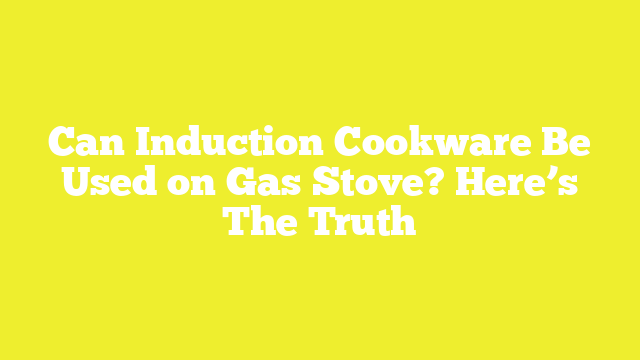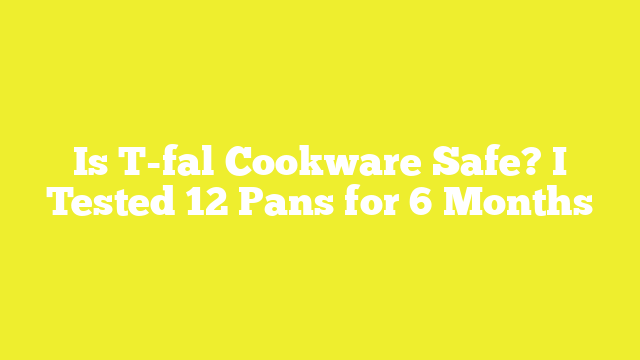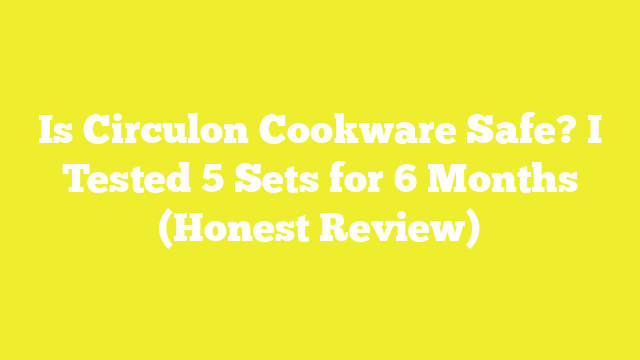Do Ceramic Pans Have Teflon? The Truth You Need to Know
Do ceramic pans have Teflon? This question has become increasingly important as we learn more about traditional non-stick cookware safety. In fact, Teflon can release toxic fumes when heated above 500°F, raising serious health concerns for home cooks.
As a result, many of us are turning to ceramic cookware as a safer alternative. Unlike Teflon-coated options, ceramic pans are free from harmful chemicals such as PTFE, PFOA, and PFOS. However, with so many options available in the market, understanding the difference between ceramic and Teflon coatings has become essential for making informed decisions about our cookware.
In this guide, we’ll explore what really goes into ceramic pans, their safety features, and how they compare to traditional Teflon-coated cookware. We’ll help you understand exactly what you’re cooking with and why it matters for your health.
Understanding Modern Cookware Coatings
Modern cookware technology has evolved significantly since the accidental discovery of Teflon in 1938. Initially developed for refrigeration research, polytetrafluoroethylene (PTFE) became the foundation for non-stick cookware after Marc Gregoire found a way to bond it to aluminum.
Types of non-stick surfaces
Today’s market offers three primary types of non-stick surfaces:
- PTFE-based coatings: Traditional non-stick surfaces made with polytetrafluoroethylene, commonly known as Teflon
- Ceramic coatings: Silicon-based surfaces created through a sol-gel process
- Anodized aluminum: Electrochemically treated surfaces with enhanced durability
PTFE coatings remain highly effective for non-stick properties, primarily because they possess the lowest coefficient of friction of any manufactured substance. Ceramic coatings, alternatively, use a silica-based gel cured onto metal cores, offering a PTFE-free alternative.
Anodized aluminum presents a distinct approach, creating a harder, darker surface through oxidation. While not technically non-stick, this process produces a durable, nonreactive surface that withstands regular use.
Evolution of cooking technology
The journey of non-stick cookware began with DuPont’s patenting of Teflon in 1941. Subsequently, the FDA approved PTFE for food processing equipment in 1960, leading to widespread adoption in home kitchens.
Throughout the 1980s and 1990s, manufacturers introduced ceramic coatings as an alternative to traditional PTFE surfaces. These newer coatings withstand higher temperatures, specifically up to 700°F compared to PTFE’s 500°F limit.
Additionally, modern manufacturing standards have eliminated previously concerning chemicals. Since 2013, PTFE production no longer uses PFOA, addressing historical safety concerns. Furthermore, ceramic coatings have gained popularity due to their naturally derived components and absence of synthetic polymers.
The latest developments include titanium-reinforced non-stick surfaces, offering 400% greater hardness than typical stainless steel. These advancements demonstrate the industry’s continuous evolution toward more durable and safer cooking surfaces.
The Truth About Ceramic Pan Materials
First and foremost, understanding ceramic cookware requires distinguishing between two fundamental types: 100% ceramic and ceramic-coated pans.
Core components
Pure ceramic cookware consists primarily of kiln-fired clay, particularly fireclay, which demonstrates exceptional heat resistance. The core components include:
- Natural minerals and oxides
- Fireclay and water mixture
- Ceramic glaze for surface protection
- Inorganic oxides for temperature resistance
Ceramic-coated cookware, alternatively, features a metal core—typically aluminum, cast iron, or stainless steel—covered with a sol-gel coating. This coating contains silica (sand) and other inorganic chemicals, creating a smooth, non-stick surface.
What’s not included
Primarily, ceramic pans exclude Teflon and other PTFE-based materials. Moreover, high-quality ceramic cookware eliminates harmful substances like PFOA and PFAS. Nevertheless, it’s crucial to note that not all ceramic coatings are identical—some lower-quality products might contain trace amounts of heavy metals.
Manufacturing standards
The FDA maintains strict regulations for ceramic cookware manufacturing. These standards specifically address potential contaminants, including lead and cadmium levels. For instance, large hollowware must not exceed 1.0 micrograms/mL of lead and 0.25 micrograms/mL of cadmium.
Manufacturing processes vary between pure ceramic and ceramic-coated cookware. Pure ceramic items undergo firing at approximately 2,500 degrees Fahrenheit in natural gas-powered kilns. Consequently, this high-temperature process creates a durable, non-reactive surface.
For ceramic-coated cookware, manufacturers employ the sol-gel method. This technique involves transforming silica into a gel-like substance that adheres to the metal base through plasma spraying. The pre-heating process opens the metal’s pores, allowing better coating adhesion.
International standards, including ISO certifications, govern various aspects of ceramic cookware production. These guidelines ensure consistent quality and safety across manufacturers. The standards cover everything from material composition to testing methods for lead and cadmium release.
Health and Safety Considerations
Safety considerations play a crucial role in selecting cookware for your kitchen. Primarily, understanding temperature thresholds and proper usage guidelines ensures both optimal cooking results and long-term health benefits.
Temperature limits
Ceramic cookware demonstrates superior heat tolerance compared to traditional non-stick options. While Teflon-coated pans begin breaking down at 500°F (260°C), ceramic coatings maintain their integrity at higher temperatures. Nevertheless, manufacturers recommend using ceramic pans at low to medium heat settings to preserve their non-stick properties.
Overheating poses distinct risks for different cookware types. Accordingly, ceramic pans should not be exposed to sustained high heat, as this accelerates coating wear. Besides, empty ceramic pans can overheat rapidly, potentially causing warping of the metallic base.
Food safety aspects
The safety profile of ceramic cookware sets it apart from traditional non-stick options. Essentially, ceramic coatings are created through a sol-gel process using silica derived from sand. This natural composition eliminates concerns about toxic fumes that can be released from overheated PTFE surfaces.
Here are critical safety guidelines for ceramic cookware use:
- Always preheat with oil or butter present
- Use wooden, silicone, or plastic utensils to prevent scratching
- Hand wash with warm, soapy water and soft sponges
- Replace pans when deep scratches appear
- Maintain proper ventilation while cooking
Ceramic coatings generally demonstrate higher heat tolerance than traditional non-stick surfaces. Overall, ceramic pans manufactured without PFAS chemicals provide a safer cooking experience. These pans don’t release harmful chemicals when heated, making them suitable for various cooking methods up to 450°F.
Undoubtedly, proper maintenance affects both safety and performance. Surface scratches in ceramic pans, though not toxic like PTFE scratches, can harbor bacteria. Altogether, while superficial marks don’t pose immediate health risks, deeper scratches might compromise food safety and require pan replacement.
Certainly, the absence of PFOA, PFOS, and PTFE in ceramic cookware addresses growing concerns about chemical exposure through cooking. This chemical-free composition eliminates risks associated with traditional non-stick surfaces, including potential thyroid disorders and other health issues.
Environmental Impact of Different Coatings
Environmental considerations shape the ongoing debate between ceramic and PTFE-based cookware. Manufacturing processes, disposal methods, and sustainability practices all play crucial roles in determining their ecological footprint.
Production process effects
The manufacturing of ceramic coatings demonstrates notable environmental advantages. Primarily, ceramic coating production requires only one application layer and less curing time, resulting in 50% lower carbon dioxide emissions than PTFE-based products.
Rather than using harmful chemicals, ceramic coatings utilize inorganic minerals, mainly silicon and oxygen. This sol-gel process creates a more environmentally conscious alternative to traditional non-stick surfaces.
Alternatively, PTFE production raises serious environmental concerns. The manufacturing process involves GenX chemicals, which studies suggest may be equally problematic as their predecessor, PFOA. These substances persist in the environment, earning them the label “forever chemicals”.
Disposal considerations
The end-of-life management of non-stick cookware presents significant environmental challenges. Presently, most unwanted non-stick cookware ends up in landfills, where it remains indefinitely. Even during recycling attempts, PFAS chemicals release into the environment.
Several states have recognized these concerns:
- California requires cookware companies to list PFAS chemicals on websites (2023) and product labels (2024)
- Connecticut, Colorado, and Vermont will ban PFAS-containing cookware sales by 2026
Sustainability factors
Forward-thinking manufacturers have begun implementing eco-conscious practices. Some notable initiatives include:
- Solar-powered manufacturing facilities
- Wastewater treatment centers
- Tree planting programs for each purchase
- Biodegradable packaging solutions
The environmental impact extends beyond production. PFAS chemicals from disposed cookware contaminate soil and water, accumulating in living organisms. These substances demonstrate remarkable persistence, potentially lasting hundreds of years in the environment.
Ultimately, the sustainability difference between ceramic and PTFE coatings becomes clear through their lifecycle impact. Ceramic coatings maintain stability at high temperatures without releasing harmful fumes. This stability not only protects user health but also prevents the release of toxic substances into the environment.
The manufacturing industry has begun responding to these concerns. In 2024, several cookware brands formed the Cookware Sustainability Alliance, though their continued advocacy for PTFE coatings raises questions about their environmental commitment. Similarly, some manufacturers now use recycled materials and implement plastic-free shipping practices to minimize their ecological footprint.
Making the Right Choice for Your Kitchen
Selecting the right cookware fundamentally comes down to understanding your kitchen needs and cooking habits. Whether you’re considering ceramic or Teflon-coated options, making an informed decision requires careful evaluation of several factors.
Cooking style assessment
Your cooking methods and preferences should guide your cookware selection. Notably, ceramic pans excel at low to medium-heat cooking, making them ideal for eggs, pancakes, and delicate foods. Alternatively, if you frequently sear meat or use high-heat cooking techniques, you might need to explore other options.
Consider these aspects when evaluating your cooking style:
- Heat Usage: Ceramic coatings maintain their integrity at temperatures up to 600°F
- Cooking Techniques: Non-stick surfaces work best for foods that tend to stick, like eggs and pancakes
- Maintenance Preferences: Hand washing extends the life of ceramic cookware markedly
- Frequency of Use: Daily cooking requires more durable options
Principally, ceramic pans offer excellent non-stick properties without PTFE, making them suitable for health-conscious cooks. Henceforth, if you’re concerned about chemical exposure, ceramic cookware presents a viable alternative to traditional non-stick options.
Budget considerations
Price shouldn’t be the only factor in your decision, yet it’s worth noting that high-quality cookware doesn’t always mean high cost. Ordinarily, ceramic skillets start at a higher price point than traditional non-stick pans. Nevertheless, several affordable options deliver excellent performance.
When evaluating costs, consider these price ranges:
- Budget ceramic pans: USD 20-30
- Mid-range options: USD 50-60
- Premium ceramic cookware: USD 100+
Evidently, investing in quality pays off. High-end ceramic pans from reputable brands tend to maintain their non-stick properties longer. Forthwith, consider starting with essential pieces rather than purchasing an entire set. A well-chosen 10-inch to 12-inch frying pan and a stockpot can handle most cooking tasks.
The longevity of your cookware significantly impacts its value. Even with proper care, ceramic coatings typically last a couple of years. This shorter lifespan should factor into your budget planning. Instead of investing in an extensive cookware set, focus on acquiring individual pieces that match your specific needs.
Quality indicators often correlate with price, yet some affordable options perform exceptionally well. For instance, several ceramic pans under USD 50 demonstrate excellent non-stick properties and heat distribution. When selecting budget-friendly options, prioritize pans with:
- Sturdy construction
- Even heating capabilities
- Comfortable handles
- Proper weight distribution
- Clear manufacturer specifications
Remember that proper care extends the life of any cookware, regardless of price point. Using appropriate utensils, avoiding high heat, and hand washing can significantly increase the longevity of ceramic coatings. These maintenance practices help maximize your investment, whether you choose budget-friendly or premium options.
Conclusion
Ceramic pans stand out as safe, environmentally conscious alternatives to traditional Teflon-coated cookware. Their natural composition eliminates concerns about harmful chemicals while offering reliable non-stick performance for everyday cooking needs. Though ceramic coatings might require more careful handling and typically last a few years, their benefits outweigh these minor drawbacks.
Smart shoppers should consider both cooking habits and budget when selecting ceramic cookware. A single high-quality pan that matches specific cooking needs often serves better than a complete set of lower-quality options. Remember that proper care – using appropriate utensils, avoiding extreme temperatures, and hand washing – significantly extends the life of ceramic cookware.
The choice between ceramic and traditional non-stick cookware affects not just cooking performance but also personal health and environmental impact. As we become more aware of these factors, ceramic cookware emerges as a practical solution for health-conscious home cooks who want reliable performance without compromising safety or environmental responsibility.





